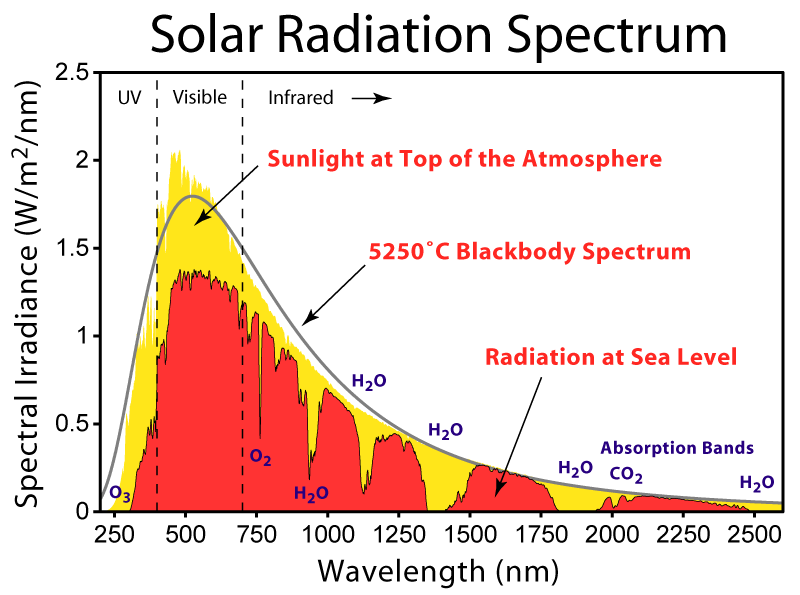Sensors that measure the available solar energy, pyranometers, are an excellent way to monitor the performance of solar photovoltaic panels. They can indicate changes in panel efficiency over time (80% of initial output after 25 years for crystalline silicon) and indicate the need for panel maintenance.
 |
| Figure 1 Spectrum of light produced by the sun and received on the surface through the atmosphere. Source: wikibooks.org |
There are two main types of pyranometers: Blackbody and silicon-cell. Blackbody pyranometers cost $1000 to $5000. Silicon pyranometers are about 10% of this cost.
Blackbody pyranometers use the thermoelectric effect to produce electricity when heated [Myers]. The detector surface has a uniform response to all wavelengths of the solar spectrum, which is defined as 280 to 2800 nm [Moore]. The sun-light incident on the detector heats the surface and a signal is generated that is proportional to the amount of light. This signal is calibrated to match the total integrated intensity of the solar spectrum.
Silicon pyranometers, on the other hand, use a silicon-based photodiode. These typically have a spectral response from about 300 to 1100 nm. Electricity is generated due to the photo-electric effect [Einstein] in the same manner that a solar panel produces electricity. Because of the spectral response, a silicon cell pyranometer subsamples the solar spectrum and its output is calibrated to match that of the entire integrated solar spectrum.
There are instances when the subsampling of a silicon based pyranometer does not accurately represent the entire solar spectrum of light coming through the atmosphere. When sunlight is filtered through the water vapor in clouds, partially-cloudy to overcast conditions, some of the infrared portion of the solar spectrum is reduced, which shifts the spectrum to the shorter wavelengths. This results in a signal from a silicon pyranometers that can be as large as 14% higher than the true total for solar radiation on heavily overcast days [Dupont].
Although blackbody pyranometers accurately measure the integrated total solar spectrum under overcast conditions, this intensity does not represent the radiation available for solar panel power production.
Since the spectral response of silicon-based pyranometers closely matches the spectral response of silicon-based solar panels [Dupont], silicon pyranometers provide better indication of the radiation energy available for conversion to electricity by the solar panel.
Thus using a silicon pyranometer will yield more accurate measurements of panel efficiency. Better measurements of panel efficiency will lead to improved understanding of changes in electrical output and solar panel response.
References
Myers DR, Stoffel TL, Reda I, Wilcox SM and Andreas AM. Recent Progress in Reducing the Uncertainty in and Improving Pyranometer Calibrations. J. Sol. Energy Eng. 124(1):44-51, Feb. 2002. DOI:10.1115/1.1434262
Moore CE, Minnaert MGJ and Houtgast J. The solar spectrum 2935 A to 8770 A. National Bureau of Standards Monograph, Washington: US Government Printing Office (USGPO), 1966.
Einstein A. On a heuristic point of view concerning the production and transformation of light. Annalen der Physik, 1905.
Dupont R, Siemer J, Hirsch M. How Much Sunlight? Photon: The Photovoltaic Magazine, 12:50-67, Dec 2010.
Seth Humphries
Product Development Scientist


No comments:
Post a Comment